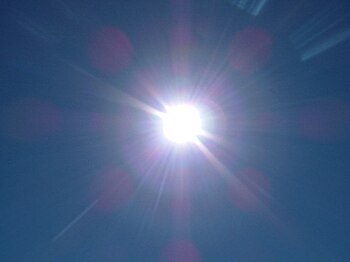Blue supergiant
You must add a |reason= parameter to this Cleanup template – replace it with {{Cleanup|November 2006|reason=<Fill reason here>}}, or remove the Cleanup template.


Blue supergiants (BSGs) are supergiant stars (luminosity class I) of spectral type O.
They are extremely hot and bright, with surface temperatures of between 20,000 - 50,000°C. They typically have 10 to 50 solar masses on the Hertzsprung-Russell diagram, and can have radii up to about 25 solar radii. These rare and enigmatic stars are amongst the hottest and brightest in the known Universe.
Because of their extreme masses they have relatively short lifespans of only 10 to 50 million years and are only observed in young cosmic structures such as open clusters, the arms of spiral galaxies, and in irregular galaxies. They are not observed in spiral galaxy cores, elliptical galaxies, or globular clusters, all of which are believed to be old.
The best known example is Rigel, the brightest star in the constellation of Orion. It has a mass of around 20 times that of the Sun and gives out more light than 60,000 suns added together. Despite their rarity and their short lives they are heavily represented among the stars visible to the naked eye; their inherent brightness trumps their scarcity.
Blue supergiants represent a slower burning phase in the death of a massive star. Due to core nuclear reactions being slightly slower, the star contracts and since very similar energy is coming from a much smaller area (photosphere) then the star's surface becomes much hotter. Red supergiants can become blue supergiants if their nuclear reactions slow for whatever reason and the reverse can also occur imploding into Pulsars.
While the solar wind from a red supergiant is dense and slow, the wind from a blue supergiant is fast but sparse. When a red supergiant becomes a blue supergiant, by contracting, the faster wind it produces impacts the already emitted slow wind and causes the outflowing material to condense into a thin shell. Almost all blue supergiants observable have this shell of material surrounding them, suggesting that they all once were red supergiants.
As the star evolves, it may swing back and forth between red supergiant (slow, dense wind) and blue supergiant (fast, sparse wind) several times and give concentric faint shells around itself. In between the transition, the star can be yellow or white in color, such as the star Polaris, the North Star. Eventually the star is likely fated to go supernova although a very small number of stars in the 8-12 solar mass range will form supergiants but will proceed to become a very rare oxygen-neon white dwarf. It is not well understood how or why these special white dwarf stars form from a star which should, by right, end up a small supernova. It is theorised, though not quantitavely, that significant mass-loss occurs during the star's supergiant phase and places it below the threshold for supernova. Either a blue supergiant or a red supergiant can go supernova as the process of a supernova is not related to the state of the star's envelope.
Since stars spend more time being red supergiants, we observe more red supergiants and most supernovae progenitors are red supergiants. It was assumed all supernovae were from red supergiants until Supernova 1987A forced revision as the progenitor was a B3 blue supergiant.
